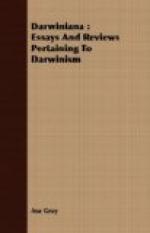1. Of characters which frequently vary upon the same branch: over a dozen such are mentioned.
2. Of those which sometimes vary upon the same branch: a smaller number of these are mentioned.
3. Those so rare that they might be called monstrosities. Then he enumerates characters, ten in number, which he has never found to vary on the same branch, and which, therefore, may better claim to be employed as specific. But, as among them he includes the duration of the leaves, the size of the cupule, and the form and size of its scales, which are by no means quite uniform in different trees of the same species, even these characters must be taken with allowance. In fact, having first brought together, as groups of the lowest order, those forms which varied upon the same stock, he next had to combine similarly various forms which, though not found associated upon the same branch, were thoroughly blended by intermediate degrees:
“The lower groups (varieties or races) being thus constituted, I have given the rank of species to the groups next above these, which differ in other respects, i.e., either in characters which were not found united upon certain individuals, or in those which do not show transitions from one individual to another. For the oaks of regions sufficiently known, the species thus formed rest upon satisfactory bases, of which the proof can be furnished. It is quite otherwise with those which are represented in our herbaria by single or few specimens. These are provisional species—species which may hereafter fall to the rank of simple varieties. I have not been inclined to prejudge such questions; indeed, in this regard, I am not disposed to follow those authors whose tendency is, as they say, to reunite species. I never reunite them without proof in each particular case; while the botanists to whom I refer do so on the ground of analogous variations or transitions occurring in the same genus or in the same family. For example resting on the fact that Quercus hex, Q. coccifera, Q. acutifolia, etc., have the leaves sometimes entire and sometimes toothed upon the same branch, or present transitions from one tree to another, I might readily have united my Q. Tlapuxahuensis to Q. Sartorii of Liebmann, since these two differ only in their entire or their toothed leaves. From the fact that the length of the peduncle varies in Q. Robur and many other oaks, I might have combined Q. Seemannii Liebm. with Q. salicifolia Nee. I have not admitted these inductions, but have demanded visible proof in each particular case. Many species are thus left as provisional; but, in proceeding thus, the progress of the science will be more regular, and the synonymy less dependent upon the caprice or the theoretical opinions of each author.”




